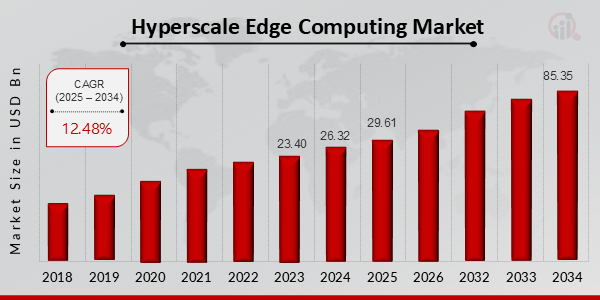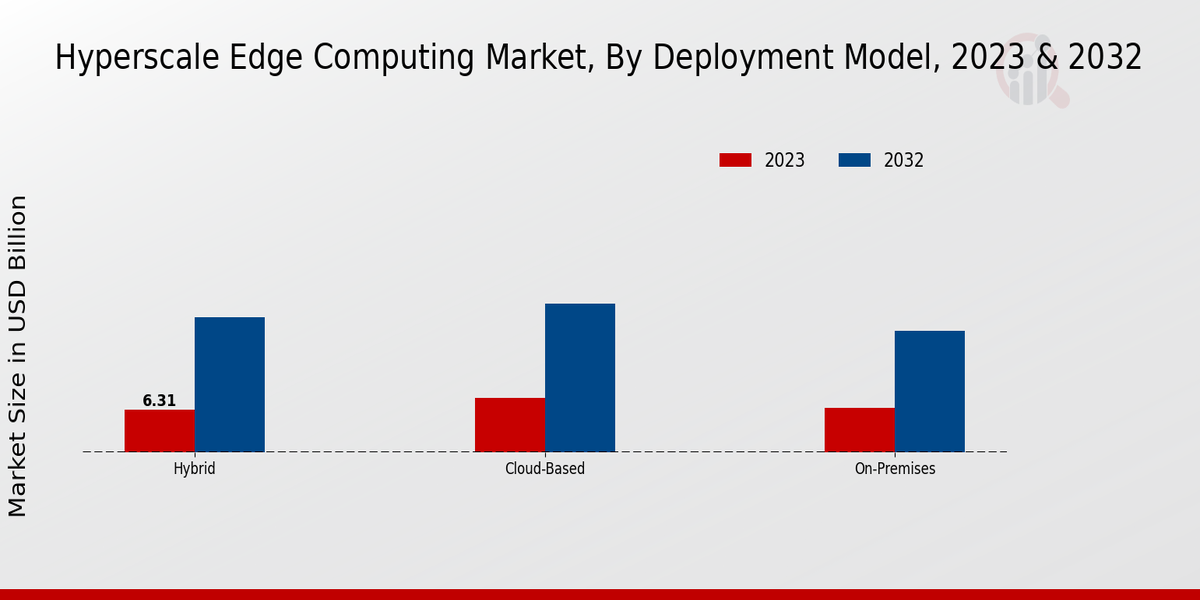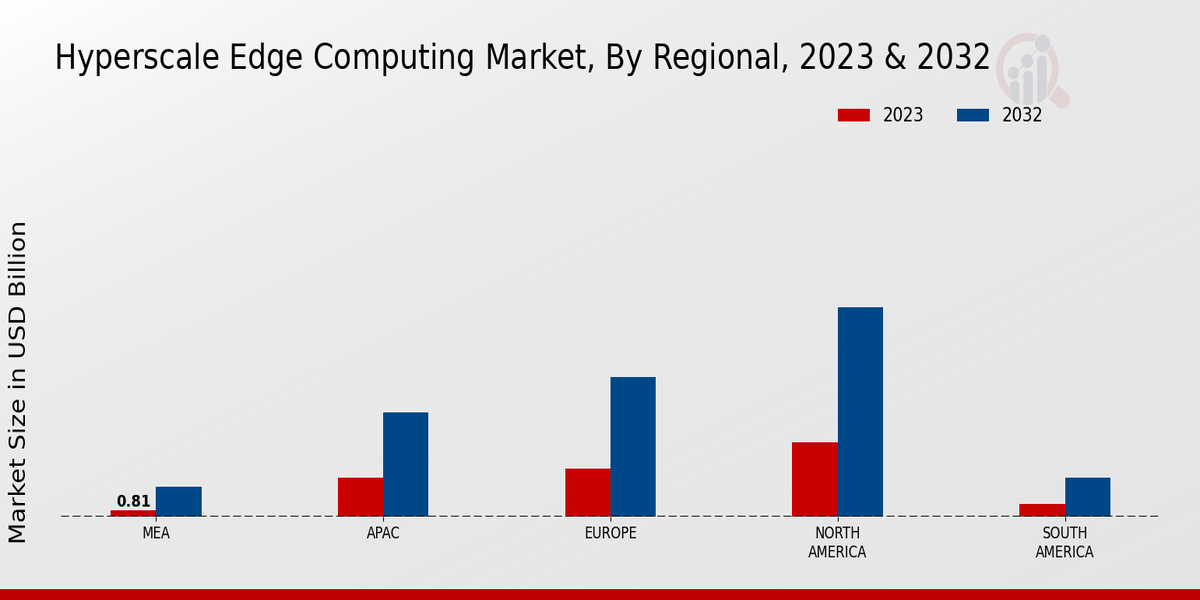Hyperscale Edge Computing Market Overview
Hyperscale Edge Computing Market is projected to grow from USD 29.61 Billion in 2025 to USD 85.35 Billion by 2034, exhibiting a compound annual growth rate (CAGR) of 12.48% during the forecast period (2025 - 2034). Additionally, the market size for Hyperscale Edge Computing Market was valued at USD 26.32 billion in 2024.
Key Hyperscale Edge Computing Market Trends Highlighted
The Hyperscale Edge Computing Market is driven by the increasing demand for reduced latency and improved performance in applications. As businesses rely more on data-intensive processes and real-time analytics, there is a significant need for edge computing solutions that can process data closer to its source. The rise of Internet of Things (IoT) devices, smart city initiatives, and the need for enhanced security measures also support the growth of this market. These factors contribute to the urgency for efficient data management and processing capabilities, pushing companies to invest in hyperscale edge infrastructure.
Opportunities within the hyperscale edge computing landscape are ripe for exploration. Businesses can capitalize on the growing concentration of data centers and the need for scalable solutions that can handle large volumes of data processing. Innovations in machine learning and artificial intelligence also present avenues for developing advanced applications that further enhance operational efficiency. Companies have the chance to expand their service offerings by integrating edge computing into existing infrastructures, meeting the demands of industries such as healthcare, automotive, and manufacturing. Recent trends indicate a movement towards hybrid architectures, merging traditional cloud services with edge capabilities.
This approach allows organizations to remain agile while benefiting from the distributed nature of edge computing. Additionally, partnerships and collaborations among technology providers are becoming more common, aimed at creating comprehensive solutions for customers. The emphasis on sustainability is also notable, as firms seek energy-efficient edge computing solutions that lessen their environmental impact. Overall, these trends signal a growing recognition of the critical role that hyperscale edge computing will play in shaping the future of IT infrastructure.
Figure 1: Hyperscale Edge Computing Market Size, 2025-2034 (USD Billion)

Source: Primary Research, Secondary Research, Market Research Future Database and Analyst Review
Hyperscale Edge Computing Market Drivers
Increased Demand for Real-Time Data Processing and Low Latency
The Hyperscale Edge Computing Market Industry is witnessing a significant shift towards real-time data processing and low-latency applications. As organizations increasingly generate and rely on vast amounts of data, the need for immediate processing has become critical. Traditional cloud computing systems often face latency issues, especially when dealing with massive volumes of data from increasingly connected devices. By leveraging edge computing capabilities, data can be processed closer to the source, dramatically reducing latency and delivering quicker responses for applications such as autonomous vehicles, smart cities, and industrial automation.
Enhanced real-time analytics empowers businesses to make quicker, more informed decisions, fostering an environment ripe for competitive advantage. Moreover, as more enterprises recognize the value of real-time insights, the demand for edge computing infrastructure that can manage data efficiently and effectively has surged, driving substantial investment into the Hyperscale Edge Computing Market Industry. This push for immediacy accelerates technological advancements and innovations, ultimately contributing to a robust growth trajectory for the market.
Growth of IoT Devices and Proliferation of Connected Networks
The proliferation of Internet of Things (IoT) devices is a powerful driver for the Hyperscale Edge Computing Market Industry. As more devices become interconnected, the volume of data generated is skyrocketing. To manage this data flow efficiently, companies require localized processing capabilities that edge computing provides. By processing data on-site instead of relying solely on centralized cloud data centers, businesses can reduce bandwidth costs while ensuring faster data insights.
This growth in IoT is not just limited to consumer devices; it extends to industrial applications, wearable tech, smart homes, and urban infrastructure, broadening the scope and potential of edge computing across various sectors.
Enhancement in Network Infrastructure and 5G Technology
Advancements in network infrastructure, particularly with the rollout of 5G technology, are significantly propelling growth in the Hyperscale Edge Computing Market Industry. The ultra-fast speeds and low latency offered by 5G networks enable the seamless integration of edge computing solutions, facilitating real-time data transmission and processing. This synergy empowers organizations to implement more sophisticated applications, such as augmented reality, virtual reality, and high-resolution video streaming.
With 5G becoming increasingly available, businesses are more inclined to adopt edge computing solutions that can handle the demands of next-generation applications, ultimately enhancing their operational efficiencies and customer experiences.
Hyperscale Edge Computing Market Segment Insights
Hyperscale Edge Computing Market Deployment Model Insights
The Deployment Model segment of the Hyperscale Edge Computing Market is a critical area that reflects the various ways organizations are implementing edge computing solutions. In 2023, the overall market is valued at 20.81 USD Billion, showcasing a growing demand for edge computing technologies. Within this segment, the Hybrid model exhibits a significant presence with a valuation of 6.31 USD Billion, which is projected to grow to 20.0 USD Billion by 2032, signaling its increasing importance as businesses seek flexible solutions that combine both cloud and on-premises resources.
The Hybrid model caters to organizations that require both the scalability of cloud infrastructure and the control of on-premises systems, making it particularly appealing for enterprises that manage sensitive data. The Cloud-Based deployment also holds a substantial position in the market with a valuation of 8.0 USD Billion in 2023, expected to reach 22.0 USD Billion by 2032. Its growth can be attributed to the increasing reliance on cloud infrastructure for its cost-effectiveness and scalability, thus dominating conversions in many sectors where cloud services can facilitate rapid deployment and resource management.
Meanwhile, the On-Premises model is valued at 6.5 USD Billion in 2023 and is projected to grow to 18.0 USD Billion by 2032. This model is particularly significant for organizations that prioritize data privacy and compliance, as it allows for complete control over the hardware and software utilized, addressing security concerns that may arise with cloud solutions.
Therefore, the Deployment Model segment of the Hyperscale Edge Computing Market not only highlights diverse implementation strategies, but also underscores the importance of understanding client needs in relation to trends around data security, operational flexibility, and the need for scalable solutions in today’s fast-evolving digital landscape. The Hyperscale Edge Computing Market segmentation points to a multifaceted approach in addressing the varied operational goals businesses face, and as these deployment models evolve, they present opportunities for innovation and growth in the market landscape.

Source: Primary Research, Secondary Research, Market Research Future Database and Analyst Review
Hyperscale Edge Computing Market Application Insights
The Hyperscale Edge Computing Market is positioned for substantial growth within the Application segment, which encompasses pivotal areas such as IoT Applications, Smart Cities, Autonomous Vehicles, Virtual Reality, and Artificial Intelligence. In 2023, the overall market is valued at 20.81 USD Billion, reflecting the increasing integration of edge computing across various applications. IoT Applications dominate the landscape, driven by the proliferation of connected devices that require real-time processing and low latency. Similarly, the emphasis on Smart Cities fuels demand for efficient data management and analytics to support urban infrastructure development.
Autonomous Vehicles leverage edge computing to enhance safety and navigation, making it a significant player in this market. Moreover, Virtual Reality and Artificial Intelligence increasingly rely on hyperscale edge computing to optimize performance and deliver immersive experiences. Currently, market growth is spurred by advancements in technology and the need for immediate data processing capabilities while challenges such as security concerns and infrastructure costs persist. Overall, the Hyperscale Edge Computing Market segmentation highlights critical areas that are essential for innovation and development in the coming years, paving the way for new opportunities and expansion.
Hyperscale Edge Computing Market Industry Insights
The Hyperscale Edge Computing Market is expected to be valued at 20.81 USD Billion in 2023, reflecting a growing demand for edge computing solutions across various industries. Telecommunications stands out as a key sector, primarily due to the expansion of 5G networks and the need for low-latency services, driving substantial investment in edge infrastructure. In the Healthcare industry, the ability to process vast amounts of data from medical devices and patient monitoring systems in real-time enhances decision-making and patient care delivery.
The Manufacturing sector is increasingly adopting edge computing to improve automation and optimize supply chain operations, leading to more efficient production processes. Retail is also witnessing significant transformations through enhanced customer experience and data analytics facilitated by edge computing solutions. The growth of these industries underscores the importance of Hyperscale Edge Computing Market segmentation, reflecting the diverse applications and revenue potential inherent in this rapidly evolving technology landscape. The Hyperscale Edge Computing Market data emphasizes the trend of integrating edge solutions to improve operational efficiencies and drive innovation across various sectors.
Hyperscale Edge Computing Market Component Insights
The Hyperscale Edge Computing Market is projected to reach a value of 20.81 USD Billion in 2023, reflecting a strong demand across various components, which encompass Hardware, Software, and Services. The Component segment is crucial, as it significantly influences overall market performance and innovation. Hardware is essential for processing data promptly at the edge, ensuring low latency and improved performance. Meanwhile, Software solutions enhance operational efficiency and facilitate data management and analytics, driving market growth.
Additionally, Services play a vital role in supporting the deployment and integration of edge computing technologies, offering businesses the expertise needed to leverage these advancements effectively. As companies increasingly adopt edge computing to meet rising data demands and enhance operational agility, the Hyperscale Edge Computing Market data reveals a robust trend towards embracing these components, ensuring substantial growth over the forecast period. The Hyperscale Edge Computing Market statistics also suggest that the convergence of these components will create new opportunities for innovation and improved service delivery, benefiting various industries.
Hyperscale Edge Computing Market Regional Insights
The Hyperscale Edge Computing Market is witnessing substantial growth across various regional segments. In 2023, North America leads the market with a valuation of 8.5 USD Billion, making it the most significant player in this industry, largely driven by advancements in technology and cloud infrastructure. Europe follows with a valuation of 5.5 USD Billion, reflecting a robust adoption of edge computing solutions. The Asia Pacific region, valued at 4.5 USD Billion, is emerging rapidly, backed by a surge in digital transformation initiatives.
Meanwhile, the Middle East and Africa hold a value of 0.81 USD Billion, with potential growth fueled by increasing demand for localized data processing. South America, valued at 1.5 USD Billion, is developing its edge computing landscape but remains relatively smaller compared to its counterparts. North America's dominance is attributed to its established technological ecosystem, while Europe maintains significant market share due to regulatory support and investment in infrastructure. The growth prospects across these regions suggest a vibrant landscape, as each area capitalizes on unique opportunities within the Hyperscale Edge Computing Market.

Source: Primary Research, Secondary Research, Market Research Future Database and Analyst Review
Hyperscale Edge Computing Market Key Players and Competitive Insights
The Hyperscale Edge Computing Market has witnessed robust growth as organizations look to optimize their operations by leveraging edge computing technology. This growth is driven by the increasing demand for low-latency processing and the need for greater data management efficiency in real time. Amid this competitive landscape, various players are striving to offer unique solutions that meet the evolving needs of businesses across sectors such as telecommunications, cloud services, and the Internet of Things.
The landscape is characterized by the continuous evolution of technology, strategic partnerships, and substantial investments aimed at enhancing infrastructure and capabilities. The competition is intensifying as companies focus on improving their services while addressing the diverse requirements of clients looking for scalability and reduced latency through localized data processing. Fastly has established itself as a significant player in the Hyperscale Edge Computing Market, specializing in real-time data processing and content delivery. With a strong emphasis on performance and security, Fastly offers a robust platform that allows businesses to operate more efficiently at the edge.
The company’s strength lies in its commitment to innovation and the ability to rapidly deploy solutions that cater to dynamic customer needs. It has built an extensive network that enhances its service delivery capabilities, ensuring that clients experience lower latency and faster data transfer regardless of geographic location. The company’s focus on developer-friendly tools and comprehensive APIs positions it favorably within the competitive landscape, enabling organizations to seamlessly integrate edge computing features into their existing workflows. Oracle Corporation is also a prominent participant in the Hyperscale Edge Computing Market, leveraging its extensive experience in cloud-based solutions.
Oracle's edge computing offerings are characterized by their robust infrastructure and integration capabilities, enabling businesses to operate efficiently and effectively in a digitally transformed environment.
The company’s strengths include its established reputation for data management and security, which is critical as organizations demand reliable systems for sensitive information. Oracle’s strategic initiatives to enhance its edge computing portfolio through advanced analytics and machine learning capabilities allow it to differentiate itself in the market. This positions Oracle to effectively meet the demands of enterprises seeking to harness the power of edge computing while ensuring compliance and efficiency within their operations.
Key Companies in the Hyperscale Edge Computing Market Include:
Hyperscale Edge Computing Market Industry Developments
Recent developments in the Hyperscale Edge Computing Market indicate a surge in demand for innovative cloud services, particularly driven by major players such as Fastly, Oracle Corporation, and Amazon Web Services. Companies like Google Cloud and Alibaba Cloud are expanding their service offerings to accommodate edge computing needs, while Nvidia Corporation is pushing into this space with enhancements in AI and machine learning capabilities. Recent acquisitions have been notable, with Cisco Systems acquiring several smaller firms focused on edge technologies to enhance their portfolio, and IBM Corporation making strategic moves to bolster its edge computing services.
Growth is evident in market valuations, with DigitalOcean and Microsoft Corporation gaining traction from infrastructure expansions and partnerships, thereby impacting market dynamics positively. Significant investments are being directed toward equipping data centers with the latest technologies to support edge applications, which reflects a broader trend toward decentralized computing models. As competition intensifies among leading firms, we can expect ongoing advancements in service quality and infrastructure capabilities within the Hyperscale Edge Computing Market.
Hyperscale Edge Computing Market Segmentation Insights
-
Hyperscale Edge Computing Market Deployment Model Outlook
-
On-Premises
-
Hyperscale Edge Computing Market Application Outlook
-
IoT Applications
-
Hyperscale Edge Computing Market Industry Outlook
-
Telecommunications
-
Hyperscale Edge Computing Market Component Outlook
-
Hardware
-
Hyperscale Edge Computing Market Regional Outlook
-
North America
|
Market Size 2024
|
26.32 (USD Billion)
|
|
Market Size 2025
|
29.61 (USD Billion)
|
|
Market Size 2034
|
85.35 (USD Billion)
|
|
Compound Annual Growth Rate (CAGR)
|
12.48% (2025 - 2034)
|
|
Report Coverage
|
Revenue Forecast, Competitive Landscape, Growth Factors, and Trends
|
|
Base Year
|
2024
|
|
Market Forecast Period
|
2025 - 2034
|
|
Historical Data
|
2019 - 2023
|
|
Market Forecast Units
|
USD Billion
|
| Key Companies Profiled |
Fastly, Oracle Corporation, Equinix, Nvidia Corporation, DigitalOcean, Google Cloud, Alibaba Cloud, Amazon Web Services, IBM Corporation, Hewlett Packard Enterprise, Cisco Systems, Microsoft Corporation, EdgeConneX, Cloudflare, Dell Technologies |
| Segments Covered |
Deployment Model, Application, Industry, Component, Regional |
| Key Market Opportunities |
Increased demand for low-latency applications, Growing adoption of IoT solutions, Expansion of 5G infrastructure, Rising edge data processing needs, Enhanced AI and machine learning adoption |
| Key Market Dynamics |
Scalability demands, Latency reduction needs, Growing IoT applications, Increasing data generation, Enhanced security concerns |
| Countries Covered |
North America, Europe, APAC, South America, MEA |
Frequently Asked Questions (FAQ):
The projected market size of the Hyperscale Edge Computing Market in 2034 is expected to reach 85.35 USD Billion.
The expected CAGR of the Hyperscale Edge Computing Market from 2025 to 2034 is 12.48%.
North America is forecasted to have the highest market value of 24.0 USD Billion in 2032 for the Hyperscale Edge Computing Market.
The market value of the Cloud-Based deployment model in 2023 is 8.0 USD Billion.
Major players in the Hyperscale Edge Computing Market include Fastly, Oracle Corporation, Equinix, and Nvidia Corporation.
The projected market value of the Hybrid deployment model in 2032 is anticipated to reach 20.0 USD Billion.
The expected market value for the Asia-Pacific region in 2032 is 12.0 USD Billion.
The market size of the On-Premises deployment model in 2032 is expected to be 18.0 USD Billion.
The South America region is projected to grow to 4.5 USD Billion by 2032.
The Middle East and Africa region is projected to grow from 0.81 USD Billion in 2023 to 3.5 USD Billion in 2032.

















